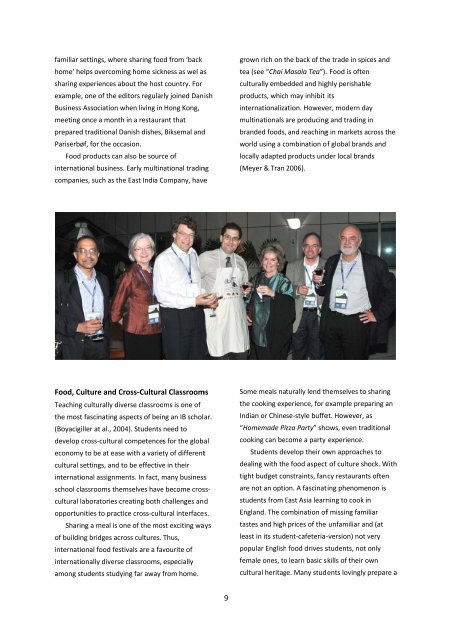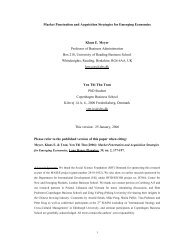AIB Cooking Book - Klaus Meyer homepage
AIB Cooking Book - Klaus Meyer homepage
AIB Cooking Book - Klaus Meyer homepage
Create successful ePaper yourself
Turn your PDF publications into a flip-book with our unique Google optimized e-Paper software.
familiar ssettings,<br />
wherre<br />
sharing food<br />
from ‘back<br />
home’ heelps<br />
overcomiing<br />
home sickness<br />
as wel ass<br />
sharing eexperiences<br />
abbout<br />
the host country. For<br />
example, , one of the edditors<br />
regular rly joined Danish<br />
Business Association wwhen<br />
living in Hong Kong,<br />
meeting once a monthh<br />
in a restaura ant that<br />
preparedd<br />
traditional DDanish<br />
dishes, Biksemal andd<br />
Pariserbøøf,<br />
for the occcasion.<br />
Food products can also be sourc ce of<br />
internatioonal<br />
businesss.<br />
Early multinational<br />
tradinng<br />
companiees,<br />
such as the<br />
East India Company,<br />
havee<br />
Food, Cuulture<br />
and CCross‐Cultura<br />
al Classroomms<br />
Teachingg<br />
culturally divverse<br />
classrooms<br />
is one of<br />
the mostt<br />
fascinating aspects<br />
of bein ng an IB scholaar.<br />
(Boyacigiiller<br />
at al., 20004).<br />
Students need to<br />
develop ccross‐cultural<br />
competences s for the globaal<br />
economyy<br />
to be at easee<br />
with a variet ty of differentt<br />
cultural ssettings,<br />
and tto<br />
be effective e in their<br />
internatioonal<br />
assignmeents.<br />
In fact, many m businesss<br />
school claassrooms<br />
themselves<br />
have e become crosss‐<br />
cultural laboratories<br />
creating<br />
both challenges c andd<br />
opportunnities<br />
to practice<br />
cross‐cultural<br />
interfaces.<br />
Sharinng<br />
a meal is oone<br />
of the mos st exciting ways<br />
of buildinng<br />
bridges acrross<br />
cultures. Thus,<br />
internatioonal<br />
food festtivals<br />
are a fav vourite of<br />
internatioonally<br />
diversee<br />
classrooms, especially<br />
among sttudents<br />
studyying<br />
far away from f home.<br />
9<br />
gr rown rich on the t back of thee<br />
trade in spic ces and<br />
te ea (see “Chai Masala M Tea”). . Food is often n<br />
cu ulturally embe edded and higghly<br />
perishable<br />
pr roducts, which h may inhibit its<br />
internationaliza<br />
ation. Howeveer,<br />
modern da ay<br />
multinationals<br />
m<br />
are producingg<br />
and trading in<br />
br randed foods, and reachingg<br />
in markets across<br />
the<br />
world<br />
using a combination<br />
oof<br />
global brand ds and<br />
lo ocally adapted products undder<br />
local brands<br />
(M <strong>Meyer</strong> & Tran 2006).<br />
So ome meals naturally<br />
lend thhemselves<br />
to sharing<br />
th he cooking exp perience, for eexample<br />
prep paring an<br />
Indian<br />
or Chinese‐style<br />
buffeet.<br />
However, as a<br />
“H Homemade Pizza<br />
Party” shoows,<br />
even traditional<br />
co ooking can become<br />
a party experience.<br />
Students de evelop their owwn<br />
approache es to<br />
de ealing with the<br />
food aspectt<br />
of culture shock.<br />
With<br />
tig ght budget co onstraints, fanncy<br />
restaurant ts often<br />
ar re not an optio on. A fascinatting<br />
phenomenon<br />
is<br />
students<br />
from East E Asia learnning<br />
to cook in<br />
En ngland. The co ombination off<br />
missing fami iliar<br />
ta astes and high prices of the unfamiliar an nd (at<br />
least<br />
in its student‐cafeteria‐<br />
‐version) not very v<br />
po opular English h food drives sstudents,<br />
not only<br />
fe emale ones, to o learn basic sskills<br />
of their own o<br />
cu ultural heritag ge. Many students<br />
lovingly prepare a



